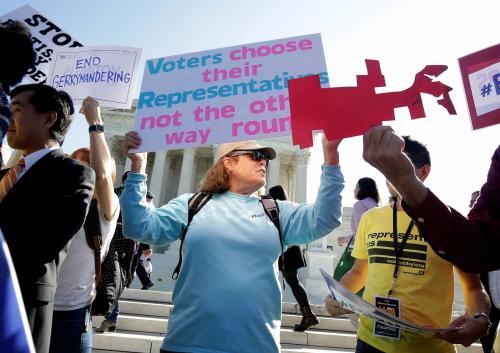Much has been made of the fact that Hillary Clinton won the nationwide popular vote while losing the Electoral College contest to Donald Trump; as of this writing, she holds an approximately 1.7 million vote lead nationwide, according to the Cook Political Report’s national popular vote tracker. At the presidential level, this kind of mismatch is a relative historical anomaly—2016 is only the fifth instance in the nation’s history where the popular vote winner did not also garner a majority of the Electoral College votes. At the congressional level, however, questions about how the share of votes won compares to the share of seats secured are common in post-election analyses, as the U.S.’s use of winner-take-all contests in single-member districts means that seats and votes do not perfectly correspond. (A purely proportional system, by contrast, would ensure that the party that wins 50 percent of the votes receives 50 percent of the seats.)
With preliminary data now available about nationwide congressional voting trends this year, we can begin to tackle some of these questions. First, while Republicans, as of this writing, received a plurality of votes cast for Congress nationwide this year—49.9 percent, again according data from the Cook Political Report—they received a greater share, 55.2 percent, of the seats. Democrats, as a result, won a smaller share of seats than they did votes: 44.8 percent of seats as compared to 47.3 percent of the votes. (These numbers may change as final vote tallies are updated.)
How does this stack up against the recent past? The figure below combines the preliminary 2016 Cook Political Report data with information from Vital Statistics on Congress to plot the share of all votes cast for House candidates nationwide won by Democrats against the share of seats held by the party at the start of the corresponding new congress since 1946. (For reference, the black line depicts a perfect linear relationship between votes and seats.) The points above the black line show years where the Democrats’ seat share outperformed their vote share, while the points below the line indicate the reverse. 2016 is denoted in red, and we can see that the past three congressional elections in 2010, 2012, and 2014 were also characterized by Democratic House candidates securing a greater share of the vote than seats.

(A brief methodological note: many analyses of this type examine only votes cast for Republicans and Democrats, also known as the two-party vote. Because Vital Stats tracks the overall share of the vote historically, I utilize that data here. The biggest difference in the graph above if we examined the two-party vote only would be that in 1952, 1996, and 2012, Democrats, in receiving a greater share of votes than seats, actually garnered a majority of the votes without winning majority of seats.)
In the past four congressional elections, then, Republicans, as the party with the majority in the House, received a “seats bonus,” wherein members of their party secured a larger share of the seats in the chamber than the share of votes won nationwide. As we see in the figure below—again using data from Vital Stats and the Cook Political Report—this is a durable feature of U.S. congressional elections. Using the overall vote share (rather than the two-party vote), the figure depicts the difference between the share of the votes and seats won by the party winning the congressional majority. The black line indicates the historical average, at 5.6 percentage points.

We see in each year since 1946, the party that wins the congressional majority realized a “seats bonus.” (A version of this analysis that examines only the two-party vote would indicate two exceptions to that pattern, in 1994 and 2006.) While the average size of the seats bonus has gotten smaller—3.9 percentage points since 1994, as compared to 6.5 percentage points between 1946 and 1992—the Republican edge in 2016—5.3 percentage points—is right in line with the historical average and is actually smaller than the comparable figures for 2012 and 2014.
Many (though not all) aspects of the 2016 presidential elections were unusual, and the forthcoming Trump administration promises to bring a range of challenges to America’s governing institutions. At the congressional level, however, much of what transpired this year was in line with recent history. Early aggregate evidence suggests that ticket splitting continued its decline as a feature of Senate elections (though we await further data to see if that claim is borne out at the individual level). In addition, the vast majority of incumbents who sought re-election were returned to Washington. As we see here, we can add the mismatch between votes and seats in favor of the House majority party to that list.
The Brookings Institution is committed to quality, independence, and impact.
We are supported by a diverse array of funders. In line with our values and policies, each Brookings publication represents the sole views of its author(s).







Commentary
Republicans in Congress got a “seats bonus” this election (again)
November 22, 2016